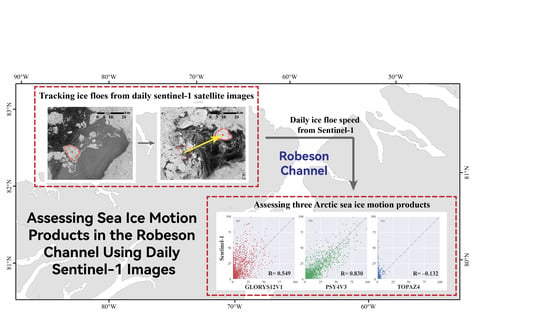An Assessment of Sea Ice Motion Products in the Robeson Channel Using Daily Sentinel-1 Images
Abstract
:1. Introduction
2. Materials and Methods
2.1. Study Area
2.2. Data
2.2.1. Sea Ice Motion Products
GLORYS12V1
PSY4V3
TOPAZ4
2.2.2. Sentinel-1 Data
2.2.3. Wind Speed and Tide Level Data
2.3. Methods
2.3.1. Estimation of Sea Ice Motion Using Sentinel-1A/-1B Images
2.3.2. Grouping of the Ice Motion Data
2.3.3. Assessment of the Sea Ice Motion Products
3. Results
3.1. Daily Ice Floe Speed
3.2. Overall Assessment
4. Discussion
4.1. Impact of the Ice Arches on the Bias of the Sea Ice Motion Products
4.2. Influence of the Wind Speed on the Accuracy of the Sea Ice Motion Products
4.3. Influence of Ice Floe Speed on the Deviation of the Sea Ice Motion Products
4.4. Influence of Tidal Forcing on the Bias of the Sea Ice Motion Products
4.5. Spatial Differences in the Accuracy of the Sea Ice Motion Products
5. Conclusions
Author Contributions
Funding
Institutional Review Board Statement
Informed Consent Statement
Data Availability Statement
Conflicts of Interest
References
- Zhang, J.; Woodgate, R.; Moritz, R. Sea ice response to atmospheric and oceanic forcing in the Bering Sea. J. Phys. Oceanogr. 2010, 40, 1729–1747. [Google Scholar] [CrossRef]
- Spreen, G.; Kwok, R.; Menemenlis, D. Trends in Arctic sea ice drift and role of wind forcing: 1992–2009. Geophys. Res. Lett. 2011, 38, L19501. [Google Scholar] [CrossRef] [Green Version]
- Kwok, R. Outflow of Arctic Ocean sea ice into the Greenland and Barents Seas: 1979–2007. J. Clim. 2009, 22, 2438–2457. [Google Scholar] [CrossRef] [Green Version]
- Ricker, R.; Girard-Ardhuin, F.; Krumpen, T.; Lique, C. Satellite-derived sea ice export and its impact on Arctic ice mass balance. Cryosphere 2018, 12, 3017–3032. [Google Scholar] [CrossRef] [Green Version]
- Ionita, M.; Scholz, P.; Lohmann, G.; Dima, M.; Prange, M. Linkages between atmospheric blocking, sea ice export through Fram Strait and the Atlantic Meridional Overturning Circulation. Sci. Rep. UK 2016, 6, 32881. [Google Scholar] [CrossRef] [PubMed] [Green Version]
- Martin, T.; Gerdes, R. Sea ice drift variability in Arctic Ocean Model Intercomparison Project models and observations. J. Geophys. Res. Oceans 2007, 112, C04S10. [Google Scholar] [CrossRef] [Green Version]
- Kwok, R.; Toudal Pedersen, L.; Gudmandsen, P.; Pang, S.S. Large sea ice outflow into the Nares Strait in 2007. Geophys. Res. Lett. 2010, 37, L03502. [Google Scholar] [CrossRef] [Green Version]
- Moore, G.W.K.; Howell, S.E.L.; Brady, M.; Xu, X.; McNeil, K. Anomalous collapses of Nares Strait ice arches leads to enhanced export of Arctic sea ice. Nat. Commun. 2021, 12, 1. [Google Scholar] [CrossRef]
- Kwok, R. Variability of Nares Strait ice flux. Geophys. Res. Lett. 2005, 32, L24502. [Google Scholar] [CrossRef] [Green Version]
- Shokr, M.E.; Wang, Z.; Liu, T. Sea ice drift and arch evolution in the Robeson Channel using the daily coverage of Sentinel-1 SAR data for the 2016–2017 freezing season. Cryosphere 2020, 14, 3611–3627. [Google Scholar] [CrossRef]
- Davis, P.E.D.; Johnson, H.L.; Melling, H. Propagation and vertical structure of the tidal flow in Nares Strait. J. Geophys. Res. Oceans 2019, 124, 281–301. [Google Scholar] [CrossRef] [Green Version]
- Dumont, D.; Gratton, Y.; Arbetter, T. Modeling the dynamics of the North Water polynya ice bridge. J. Phys. Oceanogr. 2009, 39, 1448–1461. [Google Scholar] [CrossRef]
- Barber, D.; Marsden, R.; Minnett, P.; Ingram, G.; Fortier, L. Physical processes within the North Water (NOW) polynya. Atmos. Ocean 2001, 39, 163–166. [Google Scholar] [CrossRef]
- Tremblay, J.É.; Gratton, Y.; Carmack, E.C.; Payne, C.D.; Price, N.M. Impact of the large-scale Arctic circulation and the North Water Polynya on nutrient inventories in Baffin Bay. J. Geophys. Res. Oceans 2002, 107, C8. [Google Scholar] [CrossRef]
- Fernandez, E.; Lellouche, J.M. Product user manual for the Global Ocean Physical Reanalysis Product GLORYS12V1. Copernic. Prod. User Man. 2018, 4, 1–15. [Google Scholar]
- Lellouche, J.M.; Greiner, E.; Galloudec, O.L.; Garric, G.; Regnier, C.; Drevillon, M.; Benkiran, M.; Testut, C.E.; Bourdalle-Badie, R.; Gasparin, F.; et al. Recent updates to the Copernicus Marine Service global ocean monitoring and forecasting real-time 1∕12° high-resolution system. Ocean Sci. 2018, 14, 1093–1126. [Google Scholar] [CrossRef] [Green Version]
- Simonsen, M.; Hackett, B.; Bertino, L.; Røed, L.R.; Waagbø, G.A.; Drivdal, M.; Sutherland, G. Product User Manual for Arctic Ocean Physical and Bio Analysis and Forecasting Products: ARCTIC_ANALYSIS_FORECAST_PHYS_002_001_a, ARCTIC_ANALYSIS_FORECAST_BIO_002_004 and Physical and Bio Reanalysis Products: ARCTIC_REANALYSIS_PHYS_002_003, ARCTIC_REANALYSIS_BIO_002_005; CMEMS: Toulouse, France, 2019. [Google Scholar]
- Sumata, H.; Lavergne, T.; Girard-Ardhuin, F.; Kimura, N.; Tschudi, M.A.; Kauker, F.; Karcher, M.; Gerdes, R. An intercomparison of Arctic ice drift products to deduce uncertainty estimates. J. Geophys. Res. Oceans 2014, 19, 887–4921. [Google Scholar] [CrossRef] [Green Version]
- Hwang, B.; Lavergne, T. Validation and Comparison of OSI SAF Low and Medium Resolution and IFREMER/Cersat Sea Ice Drift Products; CDOP-SG06-VS02; The EUMETSAT Network of Satellite Application Facilities: Darmstadt, Germany, 2010. [Google Scholar]
- Rozman, P.; Hölemann, J.A.; Krumpen, T.; Gerdes, R.; Köberle, C.; Lavergne, T.; Adams, S.; Girard-Ardhuin, F. Validating satellite derived and modelled sea-ice drift in the Laptev Sea with in situ measurements from the winter of 2007/2008. Polar Res. 2011, 30, 7218. [Google Scholar] [CrossRef] [Green Version]
- Gui, D.; Lei, R.; Pang, X.; Hutchings, J.K.; Zuo, G.; Zhai, M. Validation of remote-sensing products of sea-ice motion: A case study in the western Arctic Ocean. J. Glaciol. 2020, 66, 807–821. [Google Scholar] [CrossRef]
- Lei, R.; Heil, P.; Wang, J.; Zhang, Z.; Li, Q.; Li, N. Characterization of sea-ice kinematic in the Arctic outflow region using buoy data. Polar Res. 2016, 35, 22658. [Google Scholar] [CrossRef]
- Ivanova, N.; Johannessen, O.M.; Pedersen, L.T.; Tonboe, R.T. Retrieval of Arctic sea ice parameters by satellite passive microwave sensors: A comparison of eleven sea ice concentration algorithms. IEEE Tran. Geosci. Remote 2014, 52, 7233–7246. [Google Scholar] [CrossRef]
- Chevallier, M.; Smith, G.C.; Dupont, F.; Lemieux, J.F.; Forget, G.; Fujii, Y.; Hernandez, F.; Msadek, R.; Peterson, K.A.; Storto, A.; et al. Intercomparison of the Arctic sea ice cover in global ocean–sea ice reanalyses from the ORA-IP project. Clim. Dynam. 2017, 49, 1137–1138. [Google Scholar] [CrossRef] [Green Version]
- Sumata, H.; Kwok, R.; Gerdes, R.; Kauker, F.; Karcher, M. Uncertainty of Arctic summer ice drift assessed by high-resolution SAR data. J. Geophys. Res. Oceans 2015, 120, 5285–5301. [Google Scholar] [CrossRef] [Green Version]
- Kwok, R.; Schweiger, A.; Rothrock, D.A.; Pang, S.; Kottmeier, C. Sea ice motion from satellite passive microwave imagery assessed with ERS SAR and buoy motions. J. Geophys. Res. Oceans 1998, 103, 8191–8214. [Google Scholar] [CrossRef]
- Samelson, R.M.; Agnew, T.; Melling, H.; Münchow, A. Evidence for atmospheric control of sea-ice motion through Nares Strait. Geophys. Res. Lett. 2006, 33, L02506. [Google Scholar] [CrossRef] [Green Version]
- Uotila, P.; Goosse, H.; Haines, K.; Chevallier, M.; Barthélemy, A.; Bricaud, C.; Carton, J.; Fučkar, N.; Garric, G.; Iovino, D.; et al. An assessment of ten ocean reanalyses in the polar regions. Clim. Dynam. 2019, 52, 1613–1650. [Google Scholar] [CrossRef] [Green Version]
- Bertosio, C.; Provost, C.; Sennechael, N.; Artana, C.; Athanase, M.; Boles, E.; Lellouche, J.M.; Garric, G. The western Eurasian Basin halocline in 2017: Insights from autonomous NO measurements and the Mercator physical system. J. Geophys. Res. Oceans 2020, 125, e2020JC016204. [Google Scholar] [CrossRef]
- Evensen, G. The ensemble Kalman filter: Theoretical formulation and practical implementation. Ocean Dynam. 2003, 53, 343–367. [Google Scholar] [CrossRef]
- Ezraty, R.; Arduin, F.; Piollé, J.F. Sea Ice Drift in the Central Arctic Estimated from Seawinds/Quickscat Backscatter Maps; Users Manual Version 2.2; IFREMER: Bretagne, France, 2006. [Google Scholar]
- Xie, J.; Bertino, L.; Counillon, F.; Lisæter, K.A.; Sakov, P. Quality assessment of the TOPAZ4 reanalysis in the Arctic over the period 1991–2013. Ocean Sci. 2017, 13, 123–144. [Google Scholar] [CrossRef] [Green Version]
- Johansson, M.; Brekke, C.; Spreen, G.; King, J.A. X-, C-, and L-band SAR signatures of newly formed sea ice in Arctic leads during winter and spring. Remote Sens. Environ. 2018, 204, 162–180. [Google Scholar] [CrossRef]
- Hersbach, H.; Bell, B.; Berrisford, P.; Hirahara, S.; Horányi, A.; Muñoz-Sabater, J.; Nicolas, J.; Peubey, C.; Radu, R.; Schepers, D.; et al. The ERA5 global reanalysis. Q. J. R. Meteorol. Soc. 2020, 146, 1999–2049. [Google Scholar] [CrossRef]
- Wrangel Bay Tide Station. Available online: https://tides.mobilegeographics.com/calendar/year/9006.html (accessed on 20 November 2020).
- Olason, E.; Notz, D. Drivers of variability in Arctic sea-ice drift speed. J. Geophys. Res. Oceans 2014, 119, 5755–5775. [Google Scholar] [CrossRef] [Green Version]
- Duong, T.; Cowling, A.; Koch, I.; Wand, M.P. Feature significance for multivariate kernel density estimation. Comput. Stat. Data Anal. 2008, 52, 4225–4242. [Google Scholar] [CrossRef]
- Nansen, F. The oceanography of the North Polar Basin. The Norwegian North Polar Expedition 1893–1896. Scient. Results 1902, 3, 186–188. [Google Scholar]
- Haller, M.; Brümmer, B.; Müller, G. Atmosphere–ice forcing in the transpolar drift stream: Results from the DAMOCLES ice-buoy campaigns 2007–2009. Cryosphere 2014, 8, 275–288. [Google Scholar] [CrossRef] [Green Version]
- Lellouche, J.M.; Legalloudec, O.; Regnier, C.; Levier, B.; Greiner, E.; Drevillon, M. Quality Information Document for Global Sea Physical Analysis and Forecasting Product GLOBAL_ANALYSIS_FORECAST_PHY_001_024; CMEMS: Toulouse, France, 2019. [Google Scholar]
- Lei, R.; Gui, D.; Heil, P.; Hutchings, J.K.; Ding, M. Comparisons of sea ice motion and deformation, and their responses to ice conditions and cyclonic activity in the western Arctic Ocean between two summers. Cold Reg. Sci. Technol. 2020, 170, 102925. [Google Scholar] [CrossRef]
- Heil, P.; Hibler, W.D. Modeling the high-frequency component of Arctic sea ice drift and deformation. J. Phys. Oceanogr. 2002, 32, 3039–3057. [Google Scholar] [CrossRef]
- Yu, X.; Rinke, A.; Dorn, W.; Spreen, G.; Lüpkes, C.; Sumata, H.; Gryanik, V.M. Evaluation of Arctic sea ice drift and its dependency on near-surface wind and sea ice conditions in the coupled regional climate model HIRHAM–NAOSIM. Cryosphere 2020, 14, 1727–1746. [Google Scholar] [CrossRef]
- Johnson, M.; Proshutinsky, A.; Aksenov, Y.; Nguyen, A.T.; Lindsay, R.; Haas, C.; Zhang, J.; Diansky, N.; Kwok, R.; Maslowski, W.; et al. Evaluation of Arctic sea ice thickness simulated by Arctic Ocean Model Intercomparison Project models. J. Geophys. Res. Oceans 2012, 117, 1–21. [Google Scholar] [CrossRef] [Green Version]
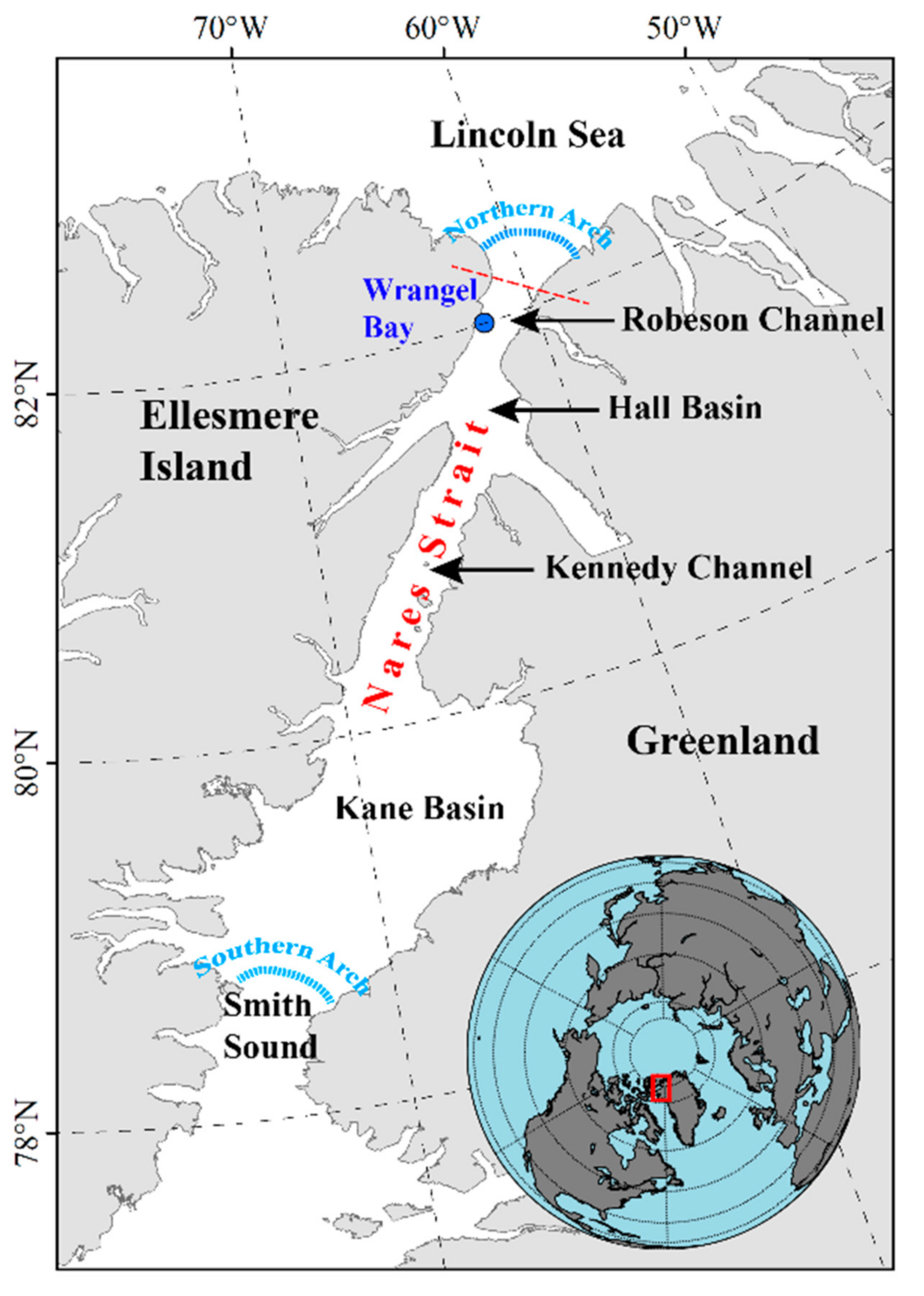
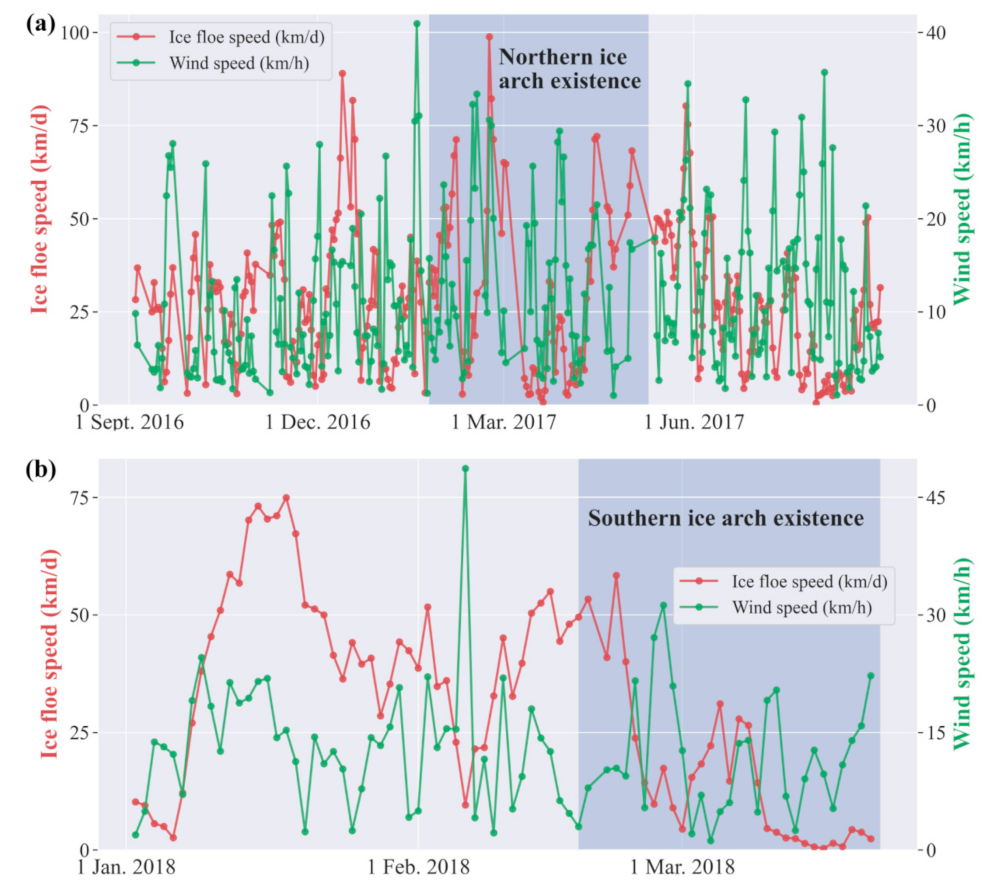

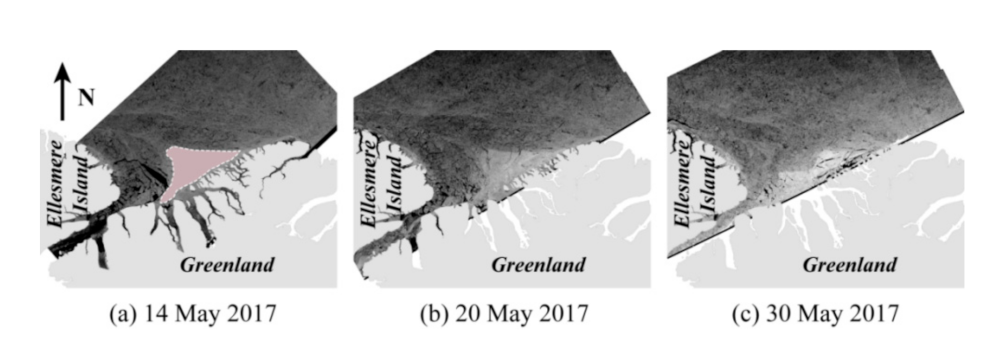

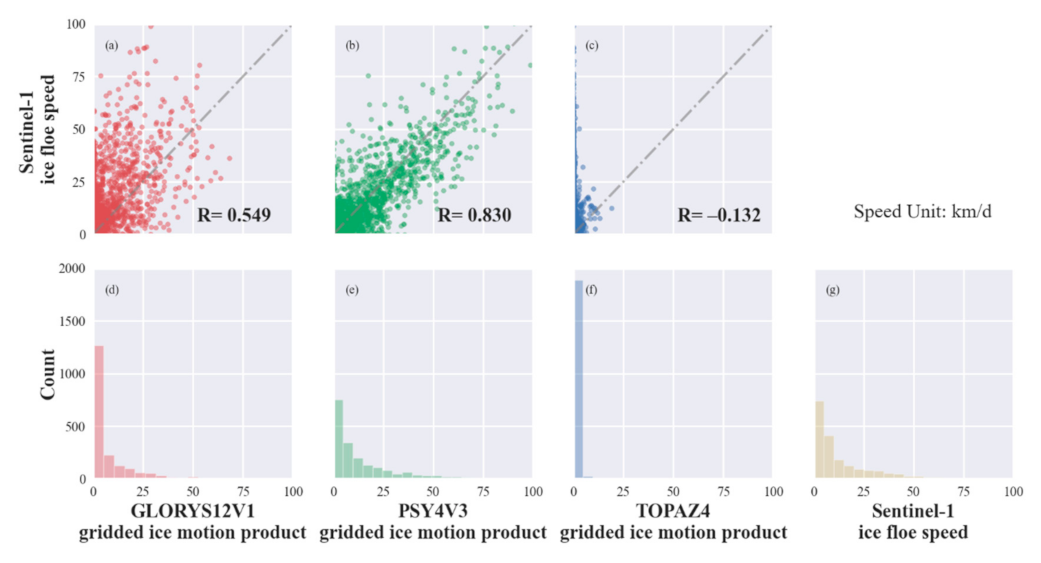


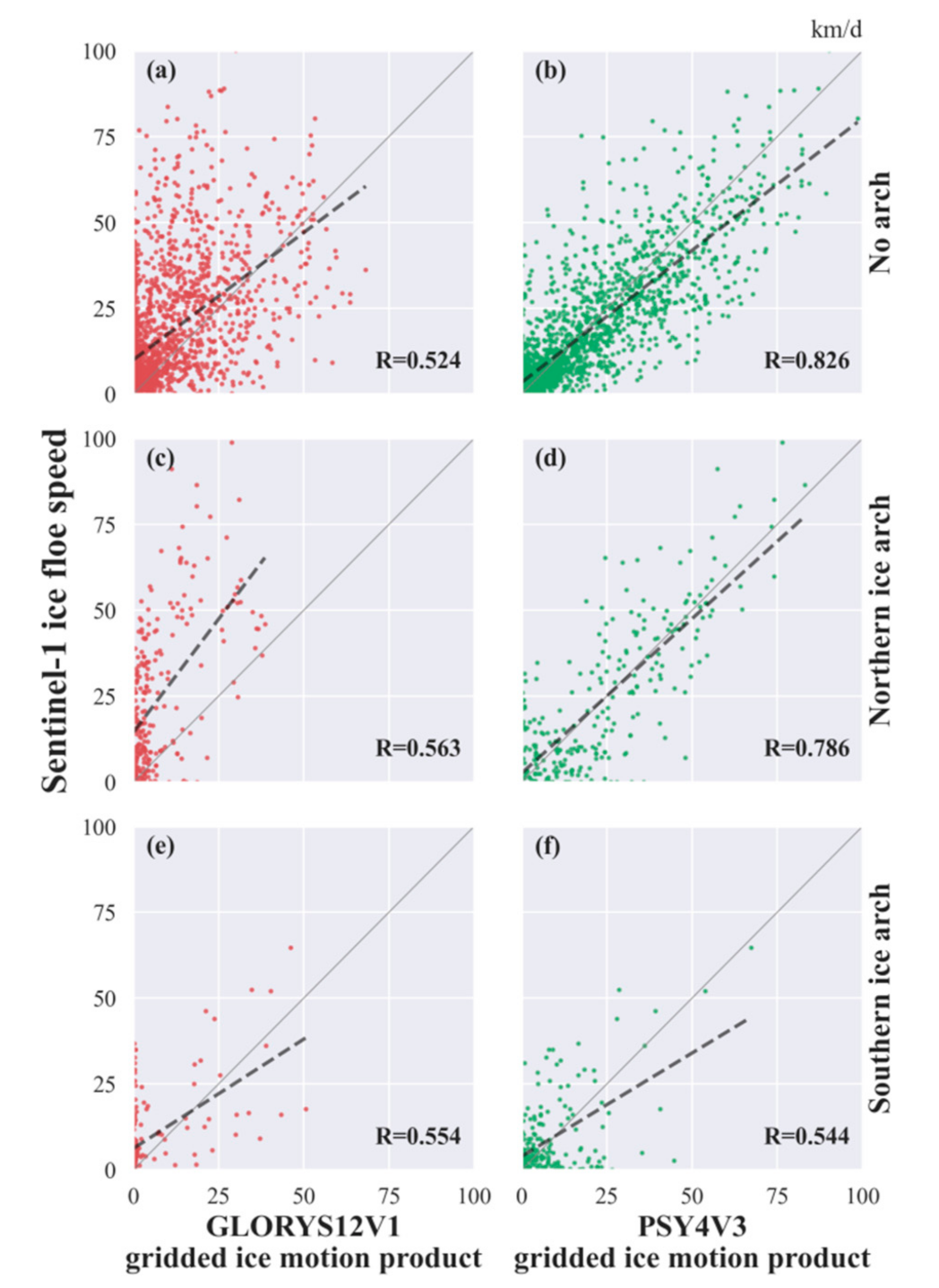
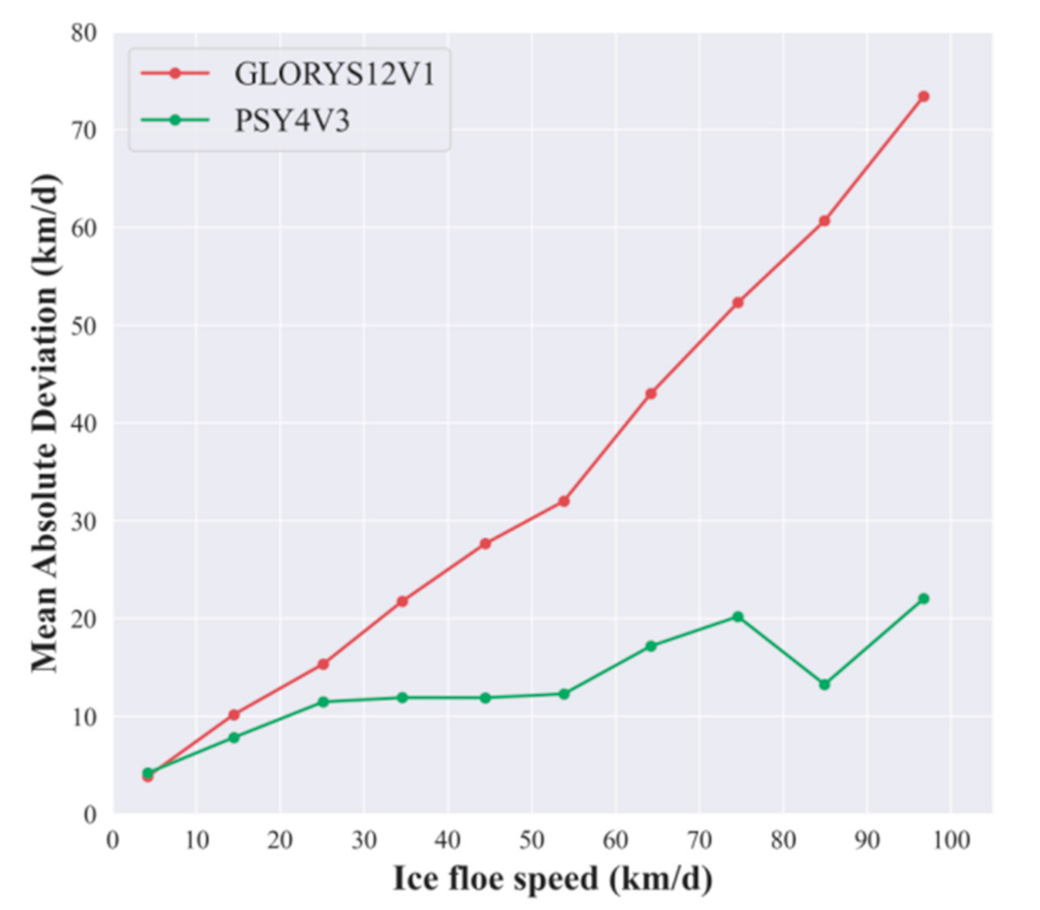
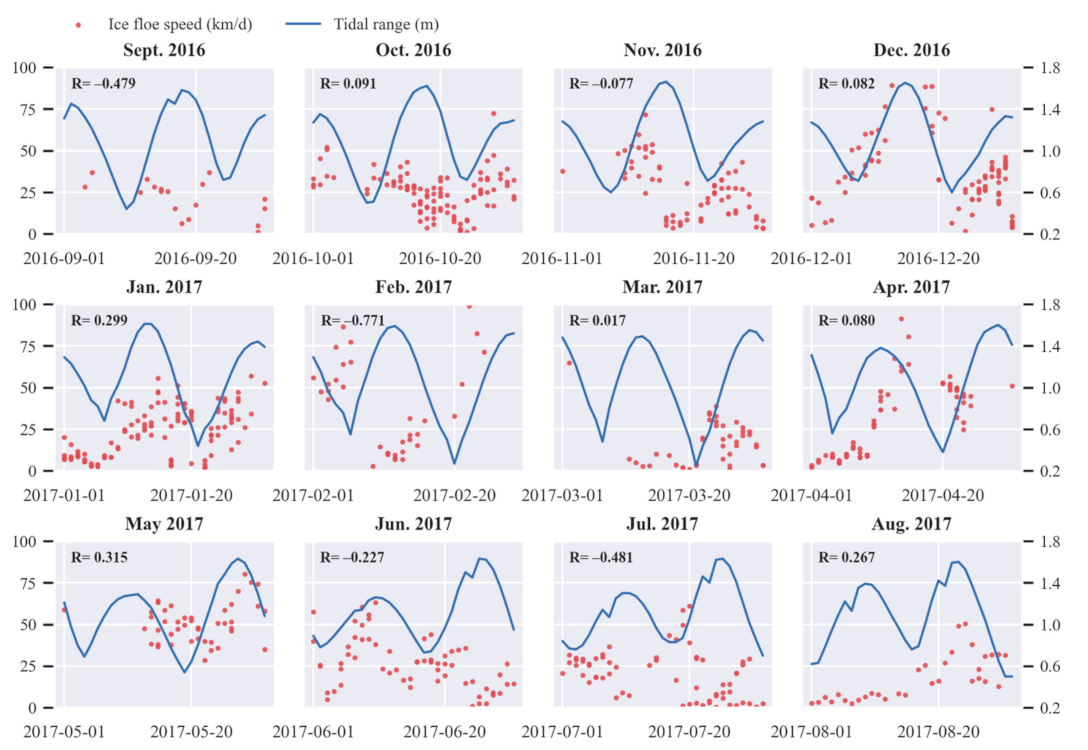
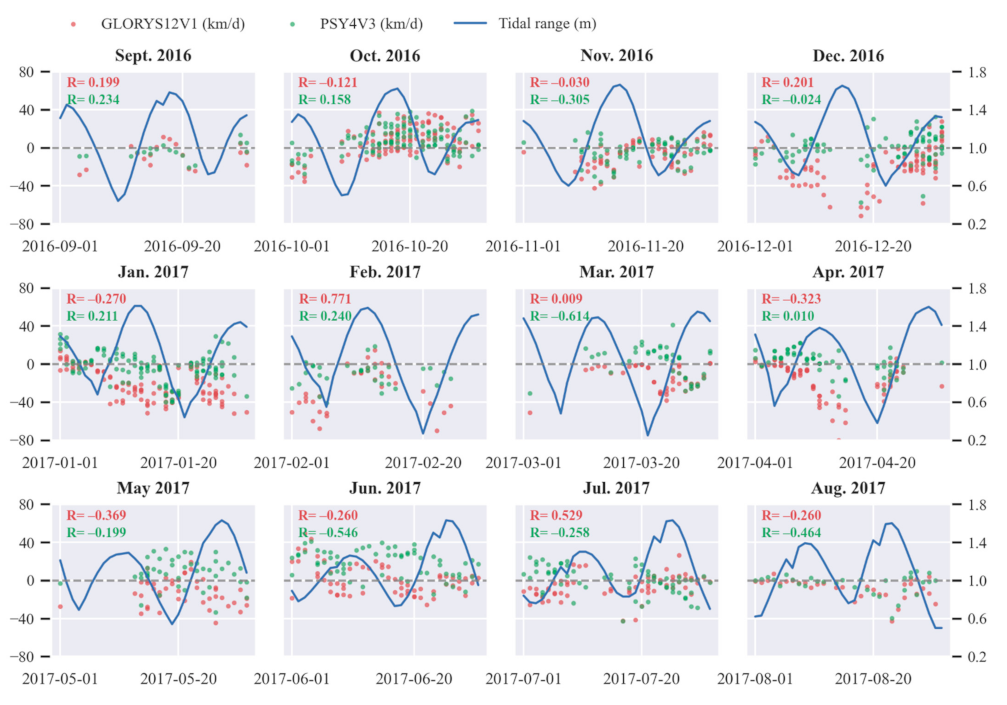
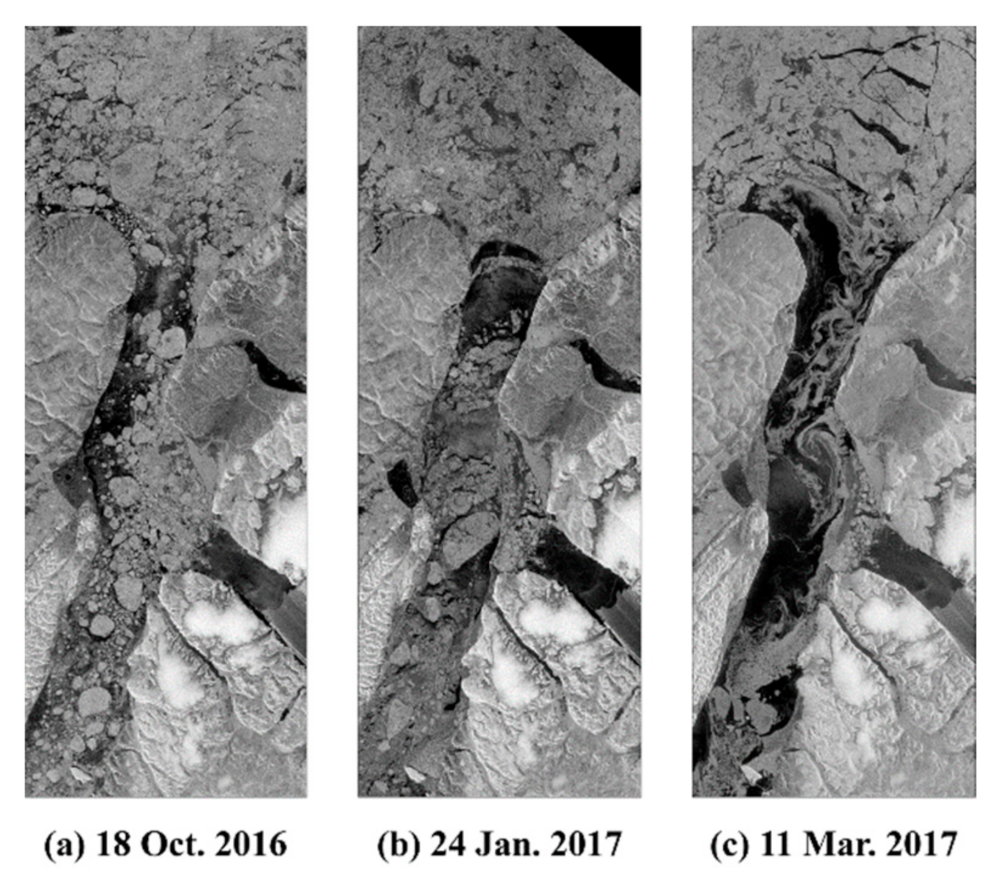
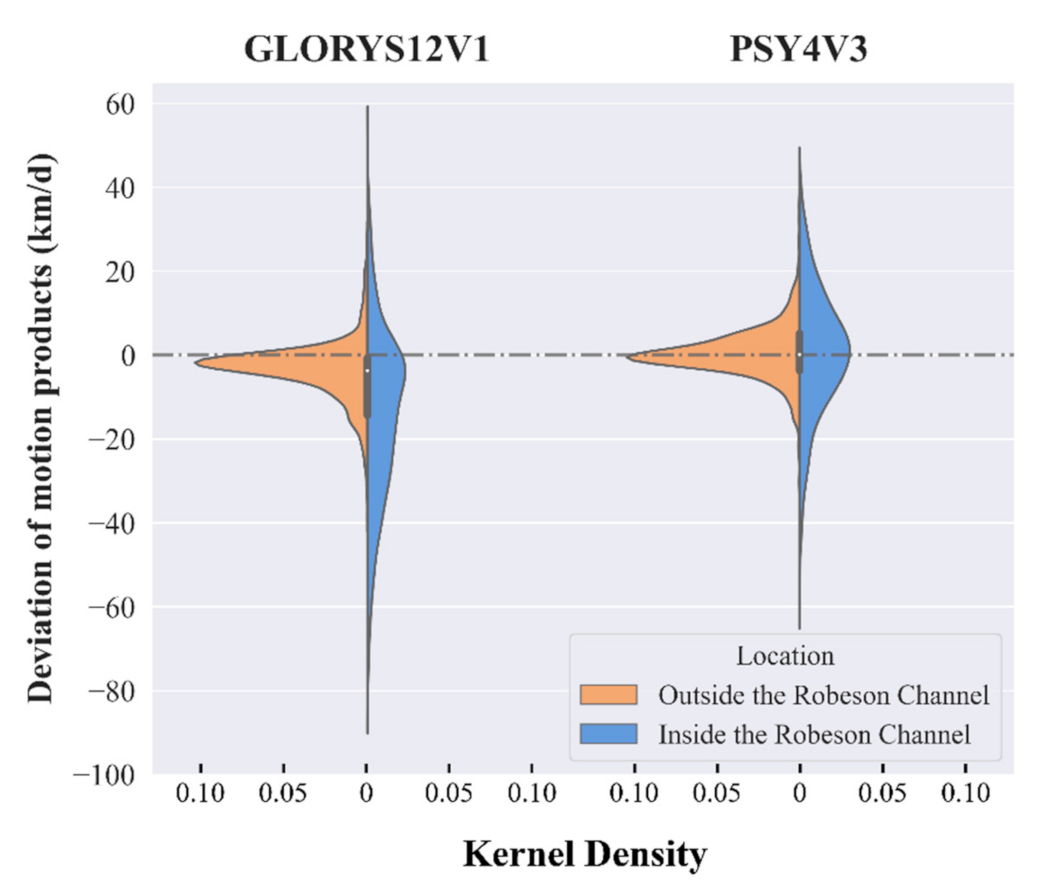
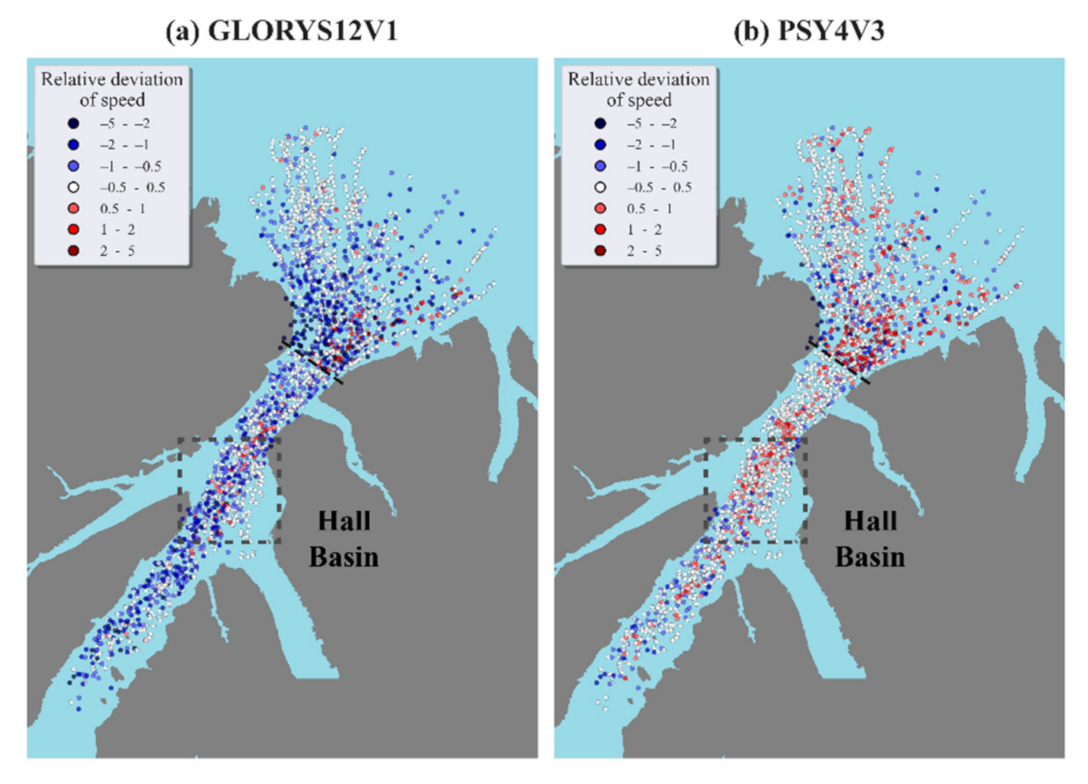
| Product | Source | Data Source | Methods | Spatial Resolution | Temporal Resolution | Period |
|---|---|---|---|---|---|---|
| GLORYS12V1 | CMEMS | CORA 4.1 T/S, NOAA SST, and CERSAT SIC | NEMO3.1 + LIM2 EVP | 1/12° | Daily | 1993–2019 |
| PSY4V3 | CMEMS | CORA 4.1 T/S, OSTIA SST, and OSI-450/430 SIC | NEMO3.1 + LIM2 EVP | 1/12° | Daily | 2016–2021 |
| TOPAZ4 | ARC MFC | QuickSCAT, AMSR-E, and SSM/I, IFREMER/CERSAT | HYCOM 2.2 + EVP sea ice model | 0.125° | Daily | 1991–2019 |
| Location | September 2016 | October 2016 | November 2016 | December 2016 | January 2017 | February 2017 | March 2017 | April 2017 |
|---|---|---|---|---|---|---|---|---|
| Outside the Robeson Channel | 24 | 400 | 229 | 83 | 62 | 29 | 15 | 14 |
| Inside the Robeson Channel | 19 | 112 | 72 | 91 | 122 | 39 | 45 | 72 |
| May 2017 | June 2017 | July 2017 | August 2017 | January 2018 | February 2018 | March 2018 | ||
| Outside the Robeson Channel | 48 | 37 | 37 | 24 | 165 | 53 | 86 | |
| Inside the Robeson Channel | 51 | 64 | 71 | 38 | 141 | 73 | 64 |
| Products | All Conditions | No Ice Arch | Northern Ice Arch | Southern Ice Arch |
|---|---|---|---|---|
| GLORYS12V1 | 0.549 | 0.524 | 0.563 | 0.554 |
| PSY4V3 | 0.830 | 0.826 | 0.786 | 0.544 |
| Wind Speed< 9.86 km/h (Mean Speed of Ice Floe = 16.22 km/d) | Wind Speed> 9.86 km/h (Mean Speed of Ice Floe = 17.12 km/d) | Difference (>9.86 Minus <9.86) | ||
|---|---|---|---|---|
| GLORYS12V1 | MAE | 9.99 km/d | 12.91 km/d | 2.92 km/d |
| RMSE | 14.45 km/d | 20.23 km/d | 5.78 km/d | |
| MAE/mean speed | 61.58% | 73.26% | 11.69% | |
| RMSE/mean speed | 89.07% | 114.81% | 25.74% | |
| PSY4V3 | MAE | 7.48 km/d | 7.31 km/d | −0.16 km/d |
| RMSE | 10.95 km/d | 11.10 km/d | 0.15 km/d | |
| MAE/mean speed | 46.10% | 41.50% | −4.60% | |
| RMSE/mean speed | 67.48% | 62.98% | −4.50% |
| Outside the Robeson Channel (Mean Speed = 7.00 km/d) | Inside the Robeson Channel (Mean Speed = 28.99 km/d) | ||
|---|---|---|---|
| GLORYS12V1 | MAE | 5.24 km/d | 19.00 km/d |
| RMSE | 7.75 km/d | 24.74 km/d | |
| MAE/mean speed | 74.97% | 65.52% | |
| RMSE/mean speed | 110.73% | 85.33% | |
| PSY4V3 | MAE | 3.98 km/d | 11.55 km/d |
| RMSE | 5.82 km/d | 15.10 km/d | |
| MAE/mean speed | 56.93% | 39.83% | |
| RMSE/mean speed | 83.22% | 52.09% |
Publisher’s Note: MDPI stays neutral with regard to jurisdictional claims in published maps and institutional affiliations. |
© 2022 by the authors. Licensee MDPI, Basel, Switzerland. This article is an open access article distributed under the terms and conditions of the Creative Commons Attribution (CC BY) license (https://creativecommons.org/licenses/by/4.0/).
Share and Cite
Liu, T.; Wang, Z.; Shokr, M.; Lei, R.; Zhang, Z. An Assessment of Sea Ice Motion Products in the Robeson Channel Using Daily Sentinel-1 Images. Remote Sens. 2022, 14, 329. https://doi.org/10.3390/rs14020329
Liu T, Wang Z, Shokr M, Lei R, Zhang Z. An Assessment of Sea Ice Motion Products in the Robeson Channel Using Daily Sentinel-1 Images. Remote Sensing. 2022; 14(2):329. https://doi.org/10.3390/rs14020329
Chicago/Turabian StyleLiu, Tingting, Zihan Wang, Mohammed Shokr, Ruibo Lei, and Zhaoru Zhang. 2022. "An Assessment of Sea Ice Motion Products in the Robeson Channel Using Daily Sentinel-1 Images" Remote Sensing 14, no. 2: 329. https://doi.org/10.3390/rs14020329





